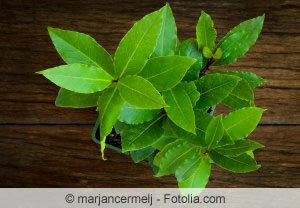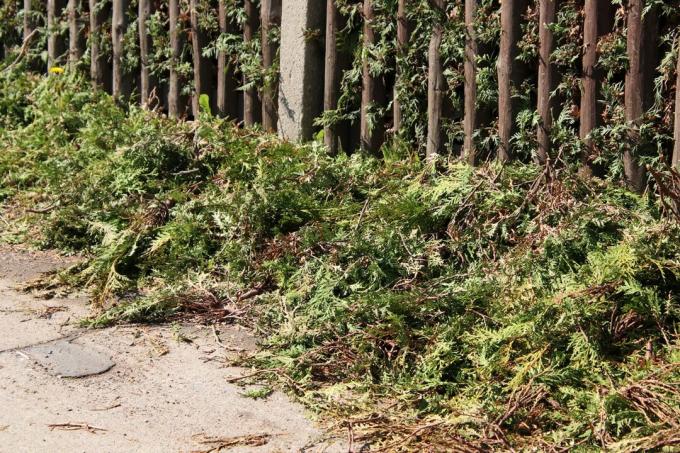

Table of contents
- Popular hedge and specimen plant
- Brown leaves on cherry laurel
- The right care
- Hardy varieties
- preventive measures
- Conclusion
Cherry laurel is an evergreen plant that does not shed its dark green foliage even in winter. Prunus laurocerasus is considered to be extremely robust and can be used in a variety of ways in the garden. The ornamental trees often have brown leaves in spring, which understandably makes many hobby gardeners despair. But contrary to what is often assumed, the withered leaves are not due to a fungal pathogen or a disease. The brown leaves are much more likely to be caused by frost or drought. You can protect your plants against this with simple means.
Popular hedge and specimen plant
Due to its fast and dense growth, cherry laurel is a coveted hedge plant. Within a short time, the wood seals off the garden from prying eyes from outside. This protection is not lost even in winter, because the plant, which belongs to the rose family, has evergreen foliage. Due to the laurel-like leaves, the plant was given the German name "Lorbeerkirsche" or "Lorbeerkirsche". Missed "Cherry Laurel". However, we strongly advise against consuming the drupes or other parts of the plant. In 2013, Prunus laurocerasus, syn.: Laurocerasus officinalisist was named poisonous plant of the year. Except for its leaf shape, cherry laurel itself has nothing to do with the right types of laurel.
Well over 20 different cultivated forms and species of laurel cherries are available in specialist shops, which differ in particular in terms of growth height and speed. But there are also differences when it comes to “frost hardness”. While some of the evergreen species can only be cultivated in regions with mild winters, others can even cope with double-digit and long-lasting minus temperatures. If the needs and requirements of the respective cherry laurel species are not met or only inadequately met, the health and growth of the ornamental tree suffer as a result. Fungal pathogens, pests and other deficiency symptoms are also often the result. Many hobby gardeners complain that their once opaque cherry laurel hedge is increasingly showing brown leaves. With just a little effort, you can restore your plants to their former glory.
Brown leaves on cherry laurel

Evergreen shrubs are easy to care for and robust. However, the plants must not be left completely to their own devices, not even in the cold season. Brown leaves on ornamental trees often appear after a long or severe winter and are often due to frost damage. However, an insufficient supply of water can also cause brown leaves and discoloration. The symptoms are particularly severe from February onwards, when the power of the sun slowly increases, but the roots of the plant cannot yet absorb water due to the frozen ground. The unsightly spots can be quickly removed in March and April:
- Cut back dead shoots down to the living tissue.
- Carefully remove brown leaves.
- In the spring you can make a strong pruning.
- Only use mechanical tools.
Do without motorized garden or hedge trimmers. Because with this type of pruning, even healthy leaves suffer massive damage, and the external appearance of the ornamental tree suffers enormously. Brown leaves on cherry laurel are unsightly side effects of incorrect cultivation of the plants. Even if the dead leaves and shoots can be removed quickly, you should get to the bottom of the cause.
Tip:
High-growth cherry laurel species can be shortened by up to 2/3. This also encourages the plant to shoot bushy.
The right care

Brown leaves on ornamental evergreens are a nuisance but rarely a cause for concern. However, in order not to always have to use scissors in the spring, you should take a few precautions. Some varieties of cherry laurel can easily endure -20°C without any noticeable damage to the plants. However, the interaction of sun, wind and frost carries a high risk for sensitive varieties. Do not make spontaneous purchases, because the cherry laurel species should not only meet your own requirements, but also easily match the prevailing climatic conditions.
Hardy varieties
- Prunus laurocerasus Caucasica: Reaches a height of up to 2.50 meters. Fast-growing variety with an increase of about 50 centimeters per year.
- Prunus laurocerasus Cherry Brandy: Rather wide-growing cherry laurel species, reaches a maximum height of about 1 meter. The growth width varies between 2 and 3.5 meters.
- Prunus laurocerasus Herbergii: Popular, hardy variety. The growth height is about 3 meters.
Another way to get a hardy variety of laurel inexpensively: make it Take a tour of the neighborhood and keep an eye out for older ones cherry laurel plants. You can tell from the outward appearance whether the plants have problems with the climate. Ask for one or more offshoots on healthy ornamental trees. If possible, plant the plants in a sheltered location.
preventive measures
Even hardy varieties of Prunus laurocerasus are not completely immune to brown leaves. This is mostly due to drought damage. Unlike deciduous plants, plants with evergreen foliage require a moderate supply of water all year round. Watering should be done on frost-free days, which is often a problem, especially in the cold season. Take precautions in autumn to enable watering in winter:
- Sufficiently loosen the soil – even with hedge plants.
- Apply a 3 to 4 centimeter thick layer of bark mulch.
- Water the plants vigorously before the first frost.
Compost is also good for protecting the soil from freezing. The material slowly decomposes, in addition to producing heat, it also releases important nutrients into the soil. The cherry laurel uses this to vigorously sprout again in early spring.

The best planting time for evergreen plants is in late summer or early spring. early autumn. Here, too, you can take preventive measures directly to get the young trees safely through the first winter. Loosen the soil sufficiently and fill the planting hole with a layer of semi-mature compost about 10 centimeters thick. Keep a sufficient minimum distance between the individual cherry laurel plants. Because then the plants do not compete with each other for water and nutrients. Incidentally, the evergreen plant must not be artificially fertilized between September and March. Even if the root ball must not dry out and regular watering is therefore necessary, the situation is different with minerals. In winter, the plants are not able to use the fertilizer optimally, damage to the above-ground and underground parts of the plant can occur.
Conclusion
Cherry laurel is a decorative plant which, given the right location and care conditions, is extremely robust and vigorous. Despite all care and precautions, however, damage can occur, especially during a harsh winter almost unavoidable due to drought and cold. Even the frost-resistant species of cherry laurel suffer underneath. Take precautions and reduce damage. Brown leaves on the laurel cherry can also be removed quickly and easily with scissors. A wrong pruning is almost impossible, because bare spots on the plant are quickly covered by the rapid growth of the ornamental tree.
 garden editorial
garden editorial I write about everything that interests me in my garden.
Learn more about hedges

Rocket juniper, Juniperus scopulorum: care tips
The rocket juniper (Juniperus scopulorum) is also known as columnar juniper and can reach impressive heights. Here we show how it can be cultivated successfully. There are also some care tips that can strengthen growth and the plant.

Conifers turn brown | reasons and solutions
Conifers are used in the garden as a hedge, group or solitary. Smaller specimens of the conifers decorate the balcony or terrace in the tub. If they turn brown, you should investigate the cause, because this behavior is usually not normal.

24 easy-care hedges – privacy without work
Hedges protect more or less well from prying eyes and are a good alternative to conventional fences. However, it is not always easy to find the right plants, especially when you want them to be as easy to care for as possible.

Pruning conifers: when is the best time?
Pruning conifers is easily possible with the right knowledge. But when is the best time for the measure and when is cutting allowed? Here is the most important information about cutting the coniferous hedge.

Fertilize thuja hedges: 7 effective fertilizers
Because of its dense growth, the Thuja is particularly valued as a hedge. In order for the growth to actually take place densely and without gaps, the plant needs sufficient nutrients. We explain how you should fertilize the tree of life for lush growth.

How fast do yews grow? | Yew hedge growth
The yew (bot. Taxus) is not without reason a popular garden and hedge plant, because it is an evergreen plant and can be easily cut into different shapes. Their growth depends on location and care.



